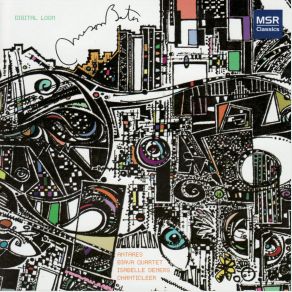Mason Bates: Digital Loom
Download links and information about Mason Bates: Digital Loom by Antares, Chanticleer, Mason Bates, Biava Quartet, Isabelle Demers. This album was released in 2009 and it belongs to Electronica genres. It contains 7 tracks with total duration of 01:03:51 minutes.

|
|
|---|---|
| Artist: | Antares, Chanticleer, Mason Bates, Biava Quartet, Isabelle Demers |
| Release date: | 2009 |
| Genre: | Electronica |
| Tracks: | 7 |
| Duration: | 01:03:51 |
| Buy it NOW at: | |
| Buy on iTunes $9.99 | |
| Buy on Amazon $7.99 | |
Tracks
[Edit]| No. | Title | Length |
|---|---|---|
| 1. | Intro: Blues 7: Intro: Blues 7 | 2:43 |
| 2. | Digital Loom: Digital Loom | 17:05 |
| 3. | Interlude: Siren Music: Interlude: Siren Music | 2:36 |
| 4. | From Amber Frozen: From Amber Frozen | 12:55 |
| 5. | Interlude: Amber: Interlude: Amber | 3:22 |
| 6. | Red River: Red River | 19:37 |
| 7. | Outro: Rhombus: Outro: Rhombus | 5:33 |
Details
[Edit]Stereo Is King collects a group of pieces by the young American composer Mason Bates, many of them written during a residency with the Chicago Symphony Orchestra. From the evidence of these works, Bates is a composer to watch. His music, with its overall emphasis on rhythm and percussion, seems distantly rooted in the minimalist movement, but it's neither pan-tonal nor rhythmically repetitive. In two works here, Bates seems to have found strong, productive principles for the use of electronics in (at least) two ways. First, he manages to evoke popular styles from blues to funk without entering "crossover" territory; rhythms are developed rather than forming the structural basis of a piece. And second, he incorporates electronics into acoustic ensembles effectively in the title track, where the contrast between electronics and conventional instruments forms a basic contrast in what the Baroque would have called a concertante structure. The title is ironic; Bates uses electronics to set off the sound of Thai and Tibetan traditional instruments that produce stereo-like reverberations, and it's both an entertaining and a challenging work. "Observer in the Magellanic Cloud," commissioned and performed by the a cappella group Chanticleer in the Maori language, similarly mixes elements of traditional culture with Bates' post-minimalist language. What's most impressive is that Bates' style remains recognizable across various ensembles (four of the six pieces do not use electronics at all) and across a great variety of themes, from references to vernacular music to futuristic conceits. This is novel music, not in the least retro, but it never leaves the audience behind.